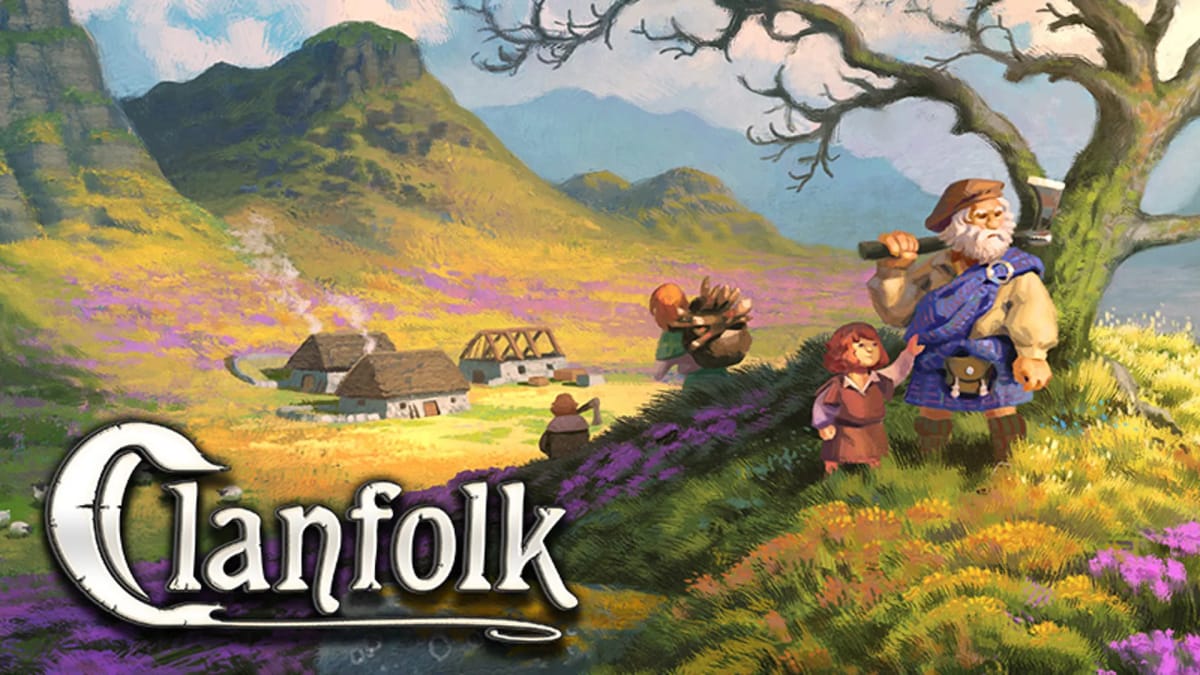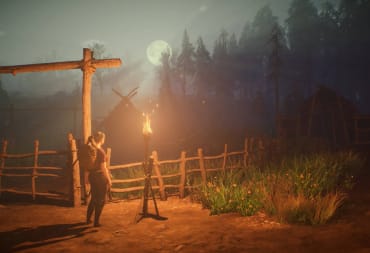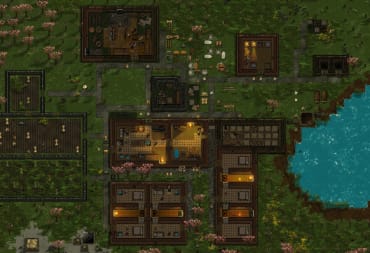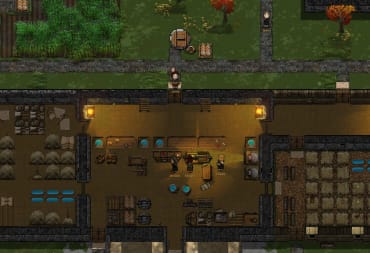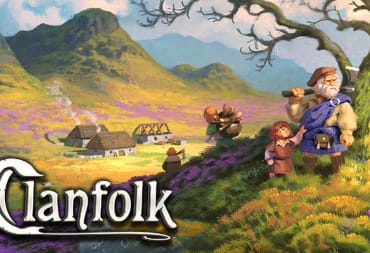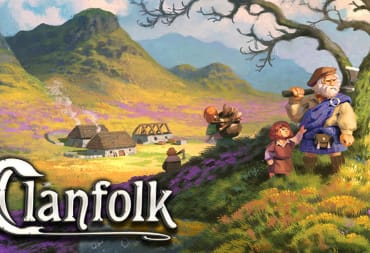Survival in Clanfolk is important, as you can imagine. Players will need to plan ahead into the future to make sure their clan makes it through the year. Early on your biggest focus should be dealing with food and slowly building up your clan's village. After that though, the next step is all about stockpiling necessities for survival. This Clanfolk Survival guide is going to look into the basic needs for survival, to make sure you get through the winter in Clanfolk.
The Flow of Survival in Clanfolk
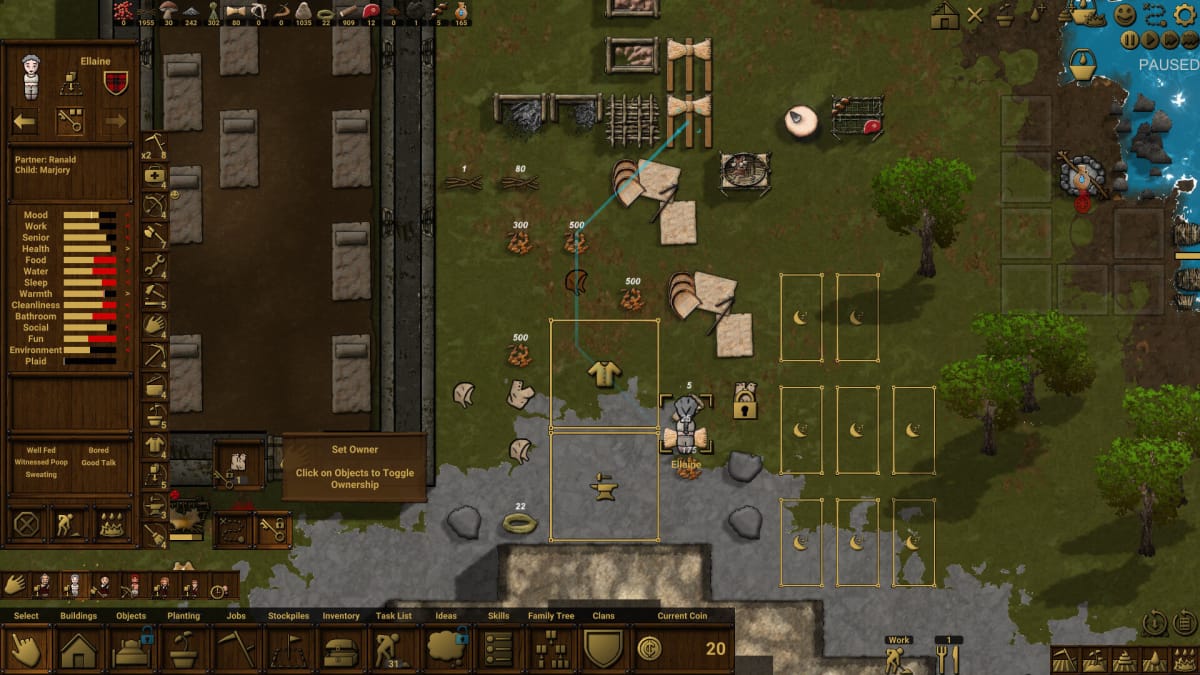
Early on in Clanfolk, your primary goals are to simply build up stockpiles of necessary materials to craft them. Along with this, you'll eventually be able to cultivate land, begin farming, and raising animals for extra food. The default setting (A Fresh Start) gives your little clan two hens, a rooster, and some dried mushrooms to start with. Over time, you will need to make sure those chickens are cared for, and hunt for more food.
After you build up your homestead though, the focus should then shift on multiple projects at a time. Three big ones include stockpiling water, creating clothing, and making fires. The three of these, along with food stockpiles, will be necessary for long-term survival, especially during the winter months where all resources will be incredibly scarce.
Clanfolk Food - Keep Enough Around
There are many resources to be found in Clanfolk, but for beginning players, perhaps the biggest focus will be making sure you have enough food stocks to survive for the long term. There are three food items early in the game that you will need to use to survive, and each of these items can utilize a few of your clan members' skills right at the start of the game, including berries, mushrooms, and eels.
As you begin to unlock new ideas and craft new items and tools, however, that will slowly replace these starting food items as your main resources. That doesn't mean you should stop gathering these however, as all of the basic foods you find will be needed for your clan even in the late game.
Berries
Gathering berries is one of the first jobs you will do in Clanfolk. Berries are collected in increments of 5 and can be stacked together in a pile of about 100. The upside is they are easy to find, you need to just forage berry bushes which are usually separated from grasslands and are pretty simple to spot. Berry bushes are also growable, so you can even create your own grove of bushes for your clan in the latter stages of the game.The downside of berries is they rot quickly, so actually picking a ton of them is a bad idea for long-term survival. The trick is to gather them progressively instead of in quantity. On average, one berry bush can yield up to 5 berries, so picking six to seven berry bushes is often enough to give you food for a day for an entire clan.
Note that early on, you want to just gather enough food for a single day, then focus on other tasks. This not only preserves your foodstocks longer term, but it also keeps easier to gather food like berries fresher longer. So actually pacing your food gathering and consumption for the early game will give you a net positive amount of food for the late game.
Mushrooms
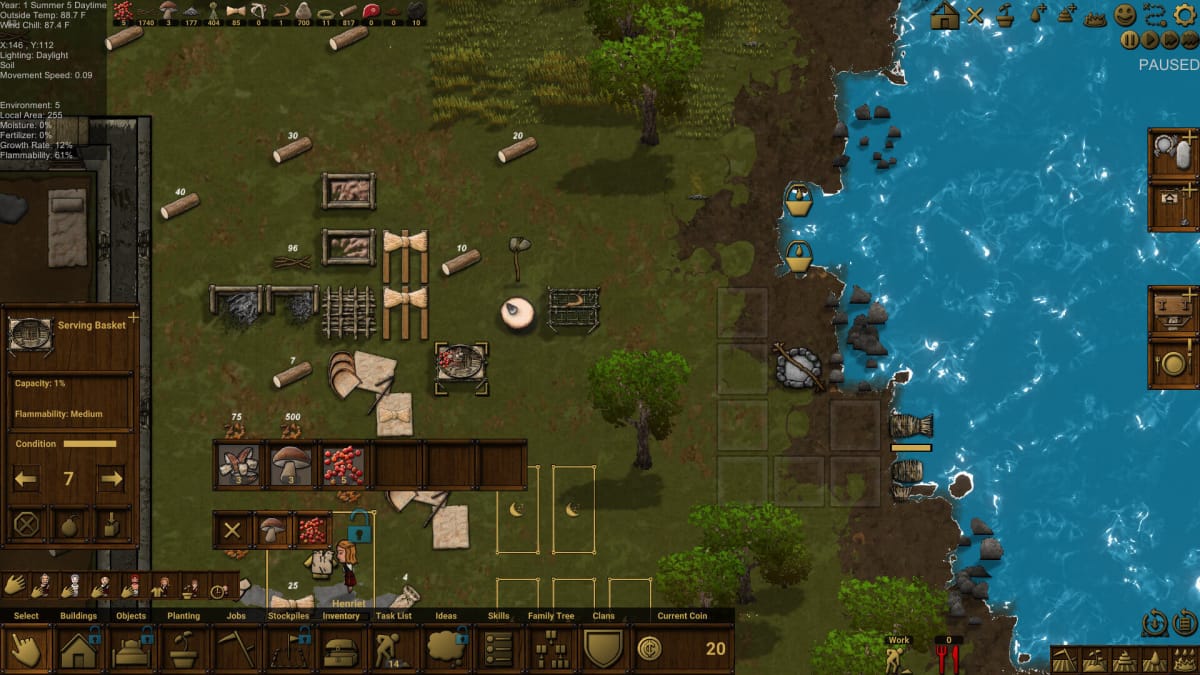
Mushrooms are more uncommon than berries, often growing in clusters at certain locations on your map. Mushrooms can’t be planted, unlike berries, but they do rot slower than berries. Mushrooms can also be dried out, which makes them last forever unless they are rained on.To get dried mushrooms you need a mushroom rack, which is a tier 23 idea. It is unlikely you will be able to dry out your mushrooms until you start successfully building up a small plot of land for your clan, including getting compost and tilled soil.
Finally, one thing I noticed is that there were more mushrooms in the fall than in the summer. It could mean that they tend to grow in the fall, making it one of the few times to really begin harvesting them, so keep your eyes peeled as mushrooms can be an invaluable food source that will last longer in the winter than most of the easy to find food sources.
Cooked Eels
The last really easy food source is Eels. Eels are a mainstay from lakes found in Clanfolk, and are easily caught because they don't require any hunting or fishing skill. They are instead caught by eel traps, which is a tier 8 idea that is often grabbed very early in the game.
To get the idea for an eel trap, you simply need to obtain the straw resource for the first time. Then, the trap needs to be built using 1 straw and 1 branch, then placed at a lakeside. The traps can catch up to 20 eels at a time, and are a fairly easy 'set and forget' item that your clan's hunters will deal with.
You can eat the eel's raw, but typically you get the ability to cook the eel right after they are captured by building a campfire. The cooked eels require raw eels and some branches but provide a lot of nutrition and rot after two days, but are arguably the best early source of food in the game until you start hunting and fishing. Cooked eels are also pretty easy to make in bulk, as you will have plenty of branches to supply the sticks needed for eels.
Wild Animals and Hunting
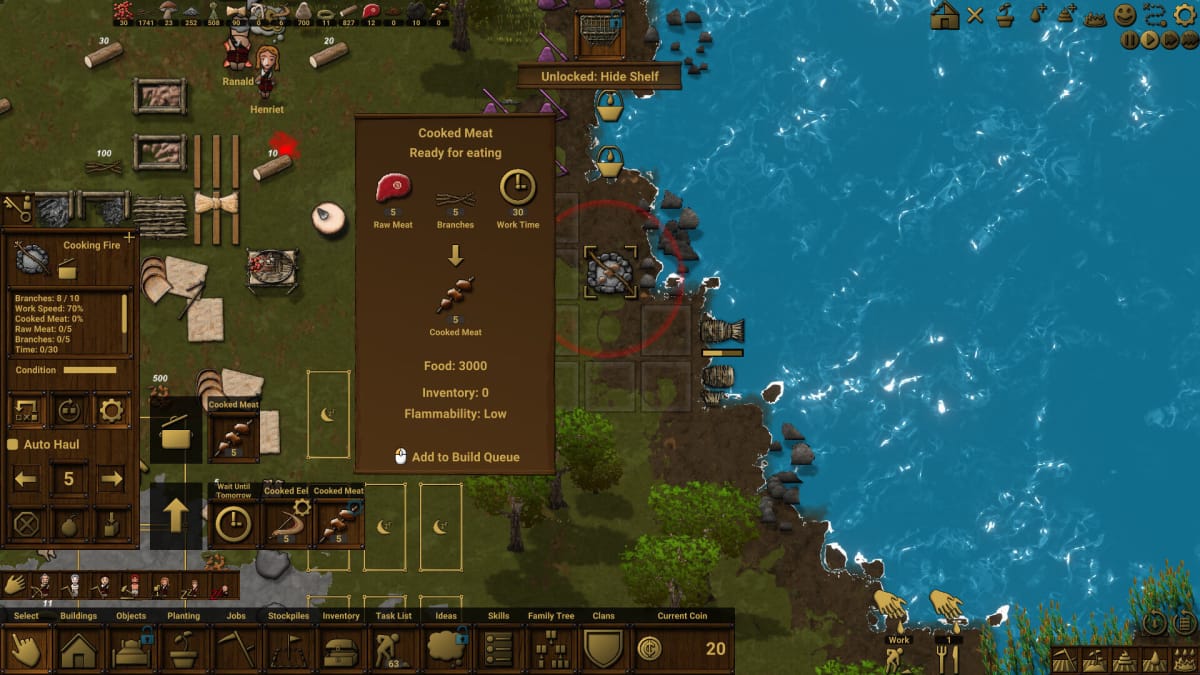
Pretty early on, you will eventually get the chance to start hunting for meat, and really dig into farming. Hunting is unlocked by crafting a simple bow, which will unlock the hunt wild animals job. There are two animals you can officially hunt, foxes, and rabbits. The amount of meat yielded by these two vary, but foxes are slightly easier to hunt because rabbits tend to run away when being chased.
There is an alternative to catching rabbits though, and that is through a snare kit, a tier 15 craftable item. Crafting a snare kit is pretty simple, requiring a work zone, branches and some straw. You then simply set them down near where rabbits live, and eventually you'll snare a critter for yourself. You will need a clan member with a high priority hunting skill to set this up, and the number of rabbits in an area can determine how likely you will catch one, so pick your spots wisely.
The other way you can hunt is through fishing. You get to unlock fishing by first gaining the tier 24 fishing spot idea, and then picking a spot on a lakeside. Fishing is a more late-game way to catch food, but getting raw fish is basically the equivalent of raw meat.
Hunting animals does require a lot more prep than eels or berries. For one, you need a butcher block, a tier 14 idea, to slaughter and cut the kills. It would also help to have a meat rack, a tier 10 idea, to store all of the raw meat until you cook it. Other parts of the animals can be used as well, especially their raw hides which require a hide rack (tier 15 idea) to transform them into a dry hide, which is used primarily for clothing. You will also need to prioritize cleaning up any blood spilt while dragging animal carcasses or cutting meat, as it lowers the environment stat on your clan members.
One more thing to consider is the choice to either cook or smoke your meat. Cooking it makes it edible, but cooked meat does rot after 2 days. Early on this will be your only choice, until you gain access to the tier 19 idea, the meat smoker. 10 pieces of raw meat and 5 branches will yield 10 resources of smoked meat, which rots after 10 days. The trade off is it's less nourishing by about 10%, but It is very important to have smoked meat ready for the winter as it may be one of your few resources of food that will survive for the duration. Keep in mind raw meat rots quickly, so like the berries, you need to hunt progressively to not waste much of anything.
Domesticated Animals
You don't have to hunt for your food in Clanfolk all the time however. There are five different domesticated animals you can have in Clanfolk; cows, pigs, chickens, goats, and sheep. Each of them has their own strengths and weaknesses for what they provide for the clan, and even their own stats to follow.
If you select A Fresh Start, you start with two hens and a rooster as your default animals. Customizable games can have you pick and choose animals though, with each of them worth different amounts at the start of the game. These costs are also reflective of any traders or commerce you engage in, which is more of a mid-late game feature when you are surviving without much issue. You can also sell the resources your animals make (eggs, milk, and wool) if you wish.
One thing to note right now about your animals; they need an indoor shelter built to survive the winter. Keeping your livestock alive requires you to invest in them this way; this means a shelter with specific access for them (either a critter door or animal accessible door to get in, for example) and enough food to keep them alive through the winter. The benefits, besides money, include steady supplies of food. An easy fix to this is an add-on to the shelter you create for your clan, that allows you easy access to the animals and provides them the space they need to survive.
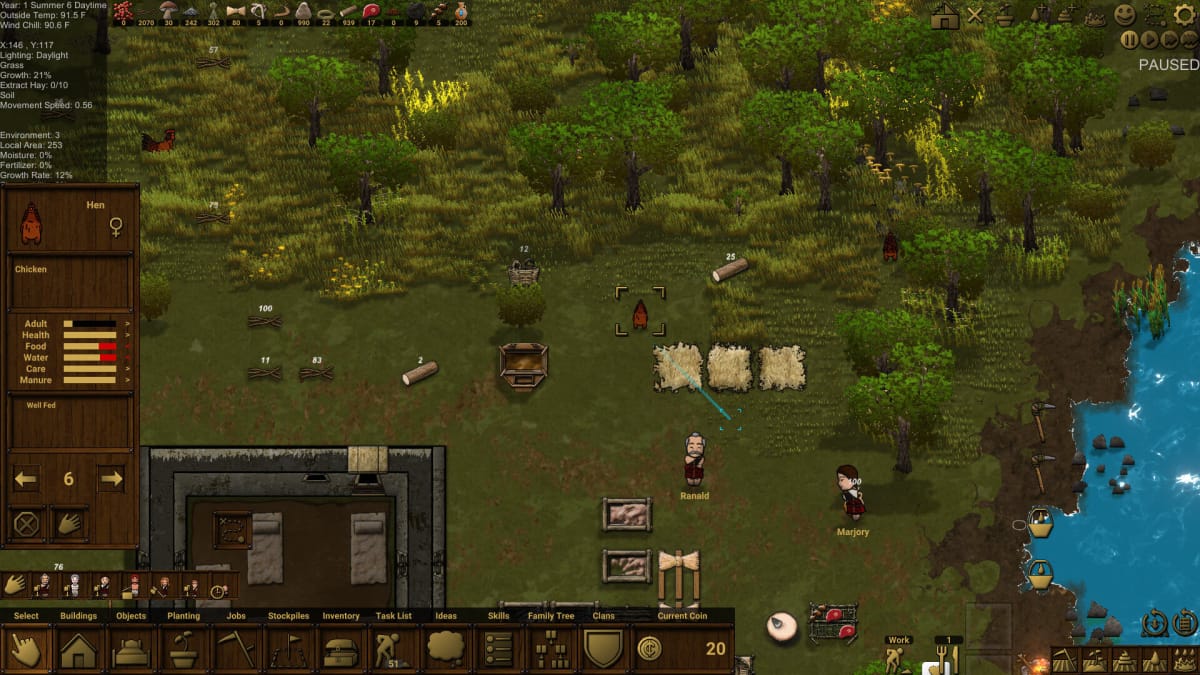
All domesticated animals require the same basic needs as your clan members. Their stats are as follows:
- Age - How old they are (typically Adult, but can also be their own versions of Juvenile or Baby)
- Health - How healthy the animal is
- Food - How well fed the animal is. Each animal has their own feeding requirements.
- Water - How thirsty the animal is.
- Care - How well cared the animals are. This includes their shelter or bed needs. All domesticated animals need at least a bed somewhere with your clan.
- Manure - How much fertilizer they are providing. You will need a gong place to store fertilizer.
Here is a breakdown of the domesticated animals:
Cattle
Cost: Bull - 150, Cow - 225
Provides: Milk
Cattle are pretty straightforward, as they simply need to graze nearby grasslands and drink water from a stream to fit their needs. When the winter comes though, you need a water trough indoors, and either a hay or grain trough to feed them. Cows can mate and create calfs for you, providing longer-term domestication for multiple seasons. Cows provide milk, which is a very useful resource because it can be processed into butter and cheese, two resources that take a while to rot away (5 and 15 days, respectively). You obviously need a cow to get milk, a milk bucket, and a butter churn or cheese press to make the processed food.
Chickens
Cost: Rooster - 50, Hen - 75
Provides: Eggs
Chickens are the easiest animal to afford and raise, requiring only a bed to keep happy. So long as they have grass and water nearby they will take care of themselves. The main reason to keep chickens is not only due to them being cheap, but because of eggs. Eggs can be fertilized to grow into baby chicks, who then grow into pullets, but they are just as useful as foodstocks, as they provide a high amount of food (1000) and have a rotting time of about 10 days. Keeping your chickens indoors is also easier than most, requiring a bed, and a grain trough for feed.
Goats
Cost: Billy - 100, Nanny - 150
Provides: Milk
Goats are basically a smaller, less expensive version of cattle. Outside of the price I didn't really notice any differences between them and cattle, their resources are also the same, milking a nanny goat gives you milk, which can be turned into butter and cheese quite easily. Because of the lower cost, if a trader does come to your clan trying to sell goats, it may be worth purchasing a few (or kid goats, so they grow up into a billy and nanny) to get the milking process started. A milking bucket is a tier 22 idea, which is more of a late game idea, but you can build up to it quickly so long as you have the goats or cattle with you.
Pigs
Cost: Boar - 80, Sow - 120
Provides: None
Pigs are currently the only animal that do not provide a specific resource, other than meat, so their major resource is really to be slaughtered for the clan. Their relative cost also makes them a steady meat supplier if you choose to breed the pigs.
Sheep
Cost: Ram - 100, Ewe - 150
Provides: Wool
Sheep are useful less for food, and more for general utility. Shearing sheep for their raw wool can turn that wool into a major resource for crafting woolen clothing, which is some of the best clothing in the game, providing the highest yields of warmth and comfort, providing you have the crafting skill for it.
Actually getting to that point is difficult. You need shears to even fleece their wool, which requires iron ingots to create. Iron ore is a mid to late game resource, (tier 18 is when iron ore first pops up) and to create an ingot you first need a smithy (tier 21), then a bloomery (tier 17), and finally, you need a clan member who has a high enough craft skill. Ingots, however, are super valuable, not just giving you shears, but the milking bucket and iron tools.
Clanfolk Farming & Water
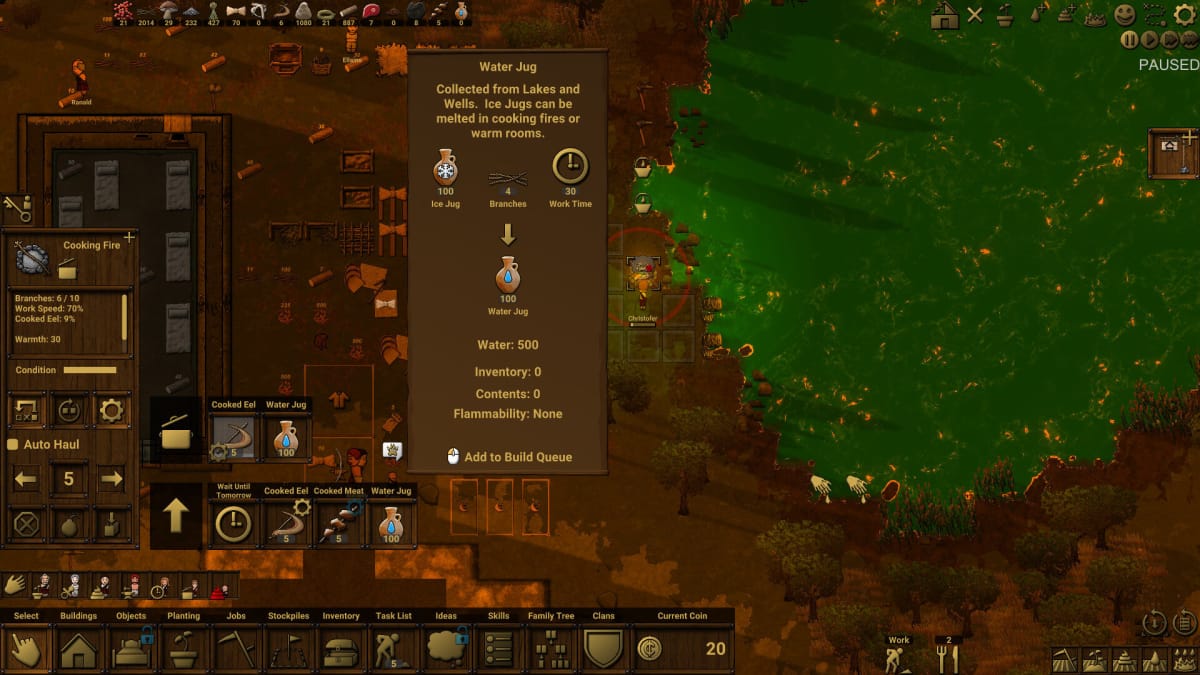
Outside of clothing and shelter, which are fairly self explanatory, water and farming are your two other major resource gains. Water is abundant in every season except the winter; so you actually have to stockpile water to survive. Water stockpiles are done through water jugs. The jugs are a craftable item built through a kiln, which requires clay and charcoal to create. You can use jugs in three different ways; to help water crops, to put out fires, and to store for the winter.
Water jugs are perhaps one of the most important resources to have on hand outside of food. Not only are they needed for survival, but they are one of the few weapons you have in the game against devastating disasters like wildfires.
The need for water jugs for farming cannot be understated either. Farming is pretty easy at first; you need to till soil with a hoe and create fields that can grow your crops. Growing and maintaining crops is heavily dependent on the right resources, but it usually follows a pattern of X amount of seeds, X amount of time, and X amount of fertilizer for growth.
The big benefit for making tilled soil is because you can set up auto jobs for your clan. In other words, they will automatically water and fertilize crops without prodding if their farming skill is a high priority. Having at least one or two clan members with a priority farming skill is good practice to keep your crops growing.
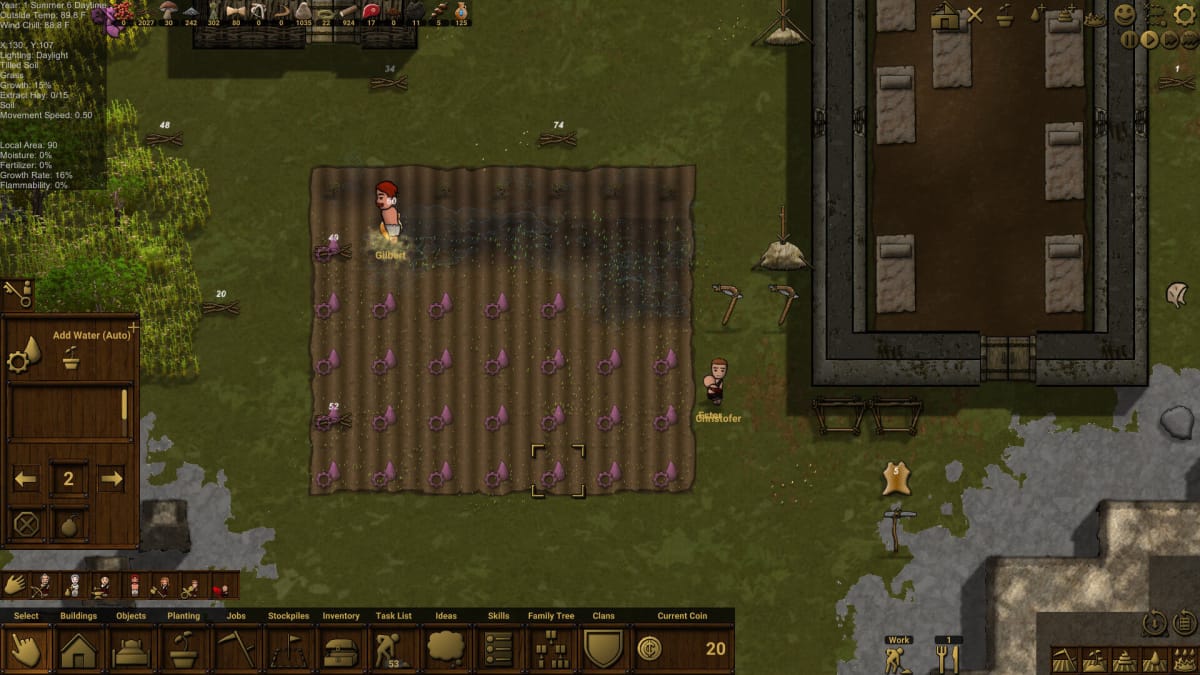
There are currently four crops that can be farmed in tilled soil; berry bushes, grass, oats and flax. Grass, oats and flax cost you their respective seeds, while berry bushes are grown from your berry supply. One other plant, reeds, can be grown too, but only along the shorelines of a lake.
Grass, Oat grain and Flax seeds can be crafted, and then planted to make more oats and flax sheaf, providing you an ample supply to both feed your livestock, have resources for advanced foods like bread, and use it for building construction. I would highly recommend getting a small patch of each if you can early on, so you can have a steady stream of resources coming in before winter. You may not think you need it with the abundance of grass around you on the map, but it does go quickly when you cut and clear it.
And that is some basic tips on food and general survival in Clanfolk. The focus on food, water and farming is just half of the battle of course, as the types of buildings, item creation, trade and commerce are also aspects of the game that you will need to interact with to survive. But, if you can hold down the food supplies, have enough water stored for the winter, and have farmland ready to grow what you need, things will come easier for you.
We hope this Clanfolk Survival Guide helped! If it did, check out more guides below:
Have a tip, or want to point out something we missed? Leave a Comment or e-mail us at tips@techraptor.net
